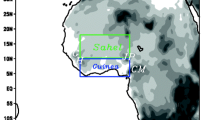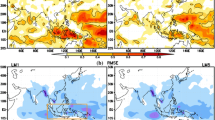Abstract
The ECHAM4 atmospheric general circulation model (GCM) has been integrated at T30 resolution through the period 1960–1994 forced with the observed sea-surface temperatures (SSTs) as compiled at the Hadley Centre (GISST2.2). Three experiments were made starting from different initial conditions. The large-scale tropical precipitation patterns simulated by the model have been studied, focusing on the skill (i.e. the capability to simulate the observed anomaly over land areas) and reproducibility (i.e. the GCM’s interannual rainfall variance that is independent from the initial conditions). Analysis of variance is used to estimate the reproducibility amongst ensemble members at each grid-box, but most emphasis is placed on large-scale patterns, as revealed by various singular value decomposition analyses (SVDAs), between observed and model fields (OM analyses) and amongst the different model runs (MM analyses). Generally, it is found that the first model mode in the MM analysis is very similar to that in the OM analysis, suggesting the model mode with strongest reproducibility is also the mode which tallies best with observations. For the global tropics, the first MM mode is highly reproducible (external variance above 90%) and the first OM couplet is very skillful (correlation between observed and model SVDA time series is over 0.84). The extent to which skill and reproducibility is related to El Nino/Southern Oscillation (ENSO) has been investigated by comparing the OM and MM time series with the Southern Oscillation Index (SOI). For the global tropics, most of the OM and MM variance is common with the SOI, though in boreal summer, the first modes do also have some clear independence from the SOI. The analyses were repeated at the regional scale for Oceania, tropical America, tropical Africa and tropical Southeast Asia. A highly reproducible mode is found in all cases except October-December in Africa. Skill, while always positive, is more variable, strongest for Oceania and tropical America and weakest for Africa. Comparisons with the SOI suggest skill in tropical America and tropical Africa has substantial components that are independent of the SOI, especially in boreal spring and summer when the tropical Atlantic SSTs are strongly related to the leading OM and MM time series.
Similar content being viewed by others
Author information
Authors and Affiliations
Additional information
Received: 1 January 1997 / Accepted: 28 July 1997
Rights and permissions
About this article
Cite this article
Moron, V., Navarra, A., Ward, M. et al. Skill and reproducibility of seasonal rainfall patterns in the tropics in ECHAM-4 GCM simulations with prescribed SST. Climate Dynamics 14, 83–100 (1998). https://doi.org/10.1007/s003820050211
Issue Date:
DOI: https://doi.org/10.1007/s003820050211




